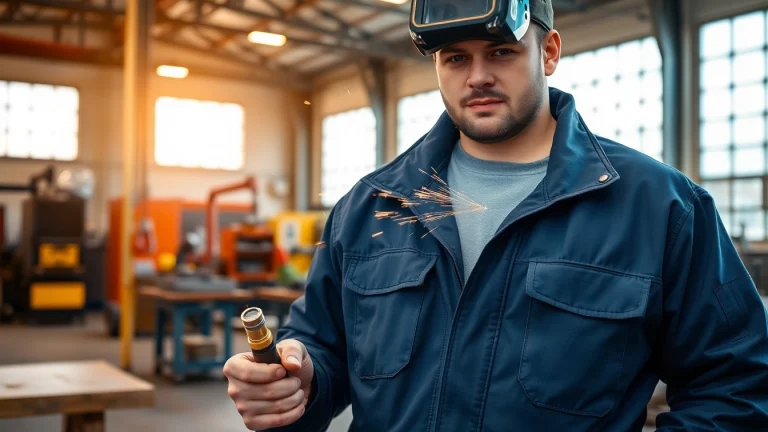
Choosing the Right Welding Jacket: Safety, Comfort, and Style
Understanding Welding Jackets
When engaging in welding activities, safety is paramount. An essential component of a welder’s personal protective equipment (PPE) is a welding jacket. Designed to shield the wearer from the intense heat, sparks, and potential spatter that occur during welding, these jackets are more than just functional—they’re also key to ensuring comfort during long hours on the job. This article aims to provide a thorough examination of welding jackets, including their importance, key features, types, care tips, and more.
What is a Welding Jacket?
A welding jacket is a type of outer garment specifically engineered for welders, providing essential protection against thermal hazards. These jackets are crafted from materials that are flame-resistant and designed to reduce the risk of burns or injuries caused by flashbacks and sparks. They come in various designs and sizes to accommodate different welding techniques and environments.
Importance of Flame Resistance
Welding generates extreme heat and sparks, which pose significant risks to welders in the form of burns and injuries. Flame-resistant clothing minimizes these dangers by preventing ignition and protecting the skin from hot metals and flames. It’s crucial for welders to invest in jackets that meet or exceed industry safety standards, ensuring adequate protection without compromising comfort or mobility.
Common Materials Used for Welding Jackets
Welding jackets are typically made from materials like:
- Cotton: Often treated with flame-retardant chemicals, cotton jackets are lightweight and breathable, making them suitable for short welding tasks and warmer climates.
- Leather: Renowned for its durability and excellent protection against sparks, leather jackets are ideal for heavy-duty welding, offering superior abrasion resistance.
- Nomex: A synthetic fabric known for its exceptional flame resistance, Nomex jackets are designed for high-performance welding environments.
- WeldX™: A proprietary fabric developed to provide a blend of comfort and flame resistance, WeldX™ jackets balance performance with lighter weight for everyday wear.
Key Features to Look For
Size and Fit Considerations
The size and fit of a welding jacket are essential for both safety and comfort. A proper fit allows for ease of movement, which is crucial during welding activities. Jackets should be snug enough to prevent sparks from entering but loose enough to allow free movement of the arms and torso. Look for adjustable features like straps, elastic cuffs, and drawstrings to customize the fit.
Added Features for Comfort
Comfort should never be overlooked when choosing a welding jacket. Key comfort features to consider include:
- Ventilation: Jackets with mesh panels or ventilated areas can help regulate body temperature during intensive tasks.
- Padded collars: These can prevent chafing around the neck, which is especially important during prolonged use.
- Multiple pockets: These allow for convenient storage of tools and personal items, reducing the need for additional carry bags.
- Wrist closures: Velcro or snap closures at the sleeve cuffs help keep sparks and debris out while providing a customizable fit.
Durability and Maintenance
A good welding jacket should be made from durable materials that can withstand heat and abrasions. When assessing durability, consider the weight of the fabric, stitching quality, and reinforcement at stress points. Additionally, maintaining the jacket’s protective qualities is vital. Regular cleaning as per the manufacturer’s instructions will help preserve its flame-resistant properties, while timely repairs can extend its lifespan significantly.
Comparing Different Welding Jacket Types
Cotton vs. Leather Welding Jackets
The choice between cotton and leather welding jackets often comes down to the specific demands of the job. Cotton jackets are generally more affordable and offer breathability, making them a popular choice for lighter welding tasks. In contrast, leather jackets provide superior protection and durable longevity, making them better suited for high-temperature environments and heavy-duty work.
Specialty Jackets for Specific Welding Methods
Specialty welding jackets are available for particular welding methods such as MIG, TIG, or Stick welding. Each type of welding may produce different levels of heat and sparks, requiring specific designs. For example, TIG welders often prefer lighter fabrics that allow for greater flexibility and precision, while MIG welders might opt for sturdier jackets that provide enhanced protection against spatter.
Eco-Friendly Options Available
With growing environmental awareness, several brands are now producing eco-friendly welding jackets made from sustainable materials. These jackets maintain the necessary protective features while utilizing recycled or organic fabrics. This option caters to welders who are conscious of their environmental impact and wish to contribute positively to sustainability efforts.
Top Brands for Welding Jackets
Established Brands to Consider
When shopping for a welding jacket, several well-known brands consistently deliver high-quality products. Brands like Miller Electric, Lincoln Electric, and Revco Black Stallion have long-standing reputations for producing reliable safety gear. These companies invest in research and development to ensure their jackets meet rigorous safety standards, providing peace of mind to users.
Emerging Brands Offering Innovative Designs
As the market evolves, new brands are emerging with innovative designs and functionality. Companies like Up In Smoke offer unique styles and hybrid materials that cater to modern welding needs. These brands often focus on combining safety features with aesthetic designs, appealing to younger generations of welders.
Brand Comparisons Based on User Reviews
User feedback is invaluable when choosing a welding jacket. Reviews often highlight specific attributes such as comfort, durability, and effectiveness in various welding environments. Comparing various brands based on customer testimonials can guide potential buyers in making informed decisions. Brands with consistently high ratings often focus on user-centered designs that prioritize ergonomic factors alongside safety.
Best Practices for Wearing and Caring for Your Welding Jacket
How to Properly Wear a Welding Jacket
When donning a welding jacket, it’s vital to ensure it fits correctly and covers all exposed skin. Each layer of clothing underneath should also be flame-resistant, as this contributes to overall protection. The jacket should be buttoned up and all closures fastened to prevent any sparks from entering. Properly adjusting the cuffs and collar provides additional safety measures against potential hazards.
Caring for Your Welding Jacket to Extend Its Lifespan
To get the most out of a welding jacket, proper maintenance is required. Follow the manufacturer’s washing instructions closely, usually involving washing with warm water and mild detergent. Avoid bleach or harsh chemicals, as these can degrade the flame-resistant treatment. Additionally, inspect the jacket regularly for signs of wear and tear, and repair any damages promptly to maintain its protective capabilities.
When to Replace Your Welding Jacket
Even with proper care, welding jackets have a finite lifespan. Signs it’s time for a replacement include visible wear, damaged materials, or compromised flame resistance. Most manufacturers suggest a replacement every year, depending on usage intensity. Regular evaluations will ensure that you always have optimal protection against weld-related hazards.
Conclusion
Investing in a quality welding jacket is essential for safety and comfort in the welding profession. By understanding the different materials, features, and brands available, welders can make informed decisions that best suit their needs. Properly wearing and maintaining a welding jacket not only prolongs its life but also enhances the wearer’s safety during welding operations. As technology and materials advance, the market for welding jackets continues to evolve, offering even greater protection tailored to the modern welder.


